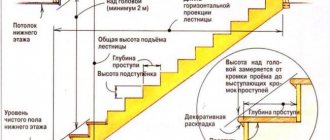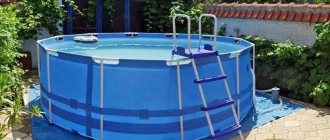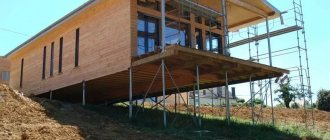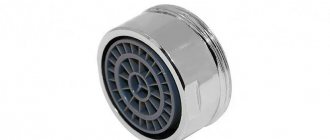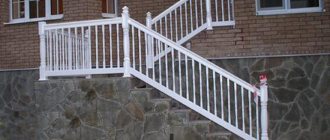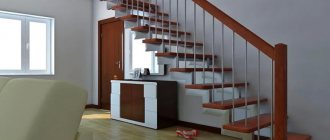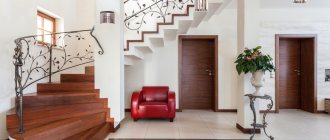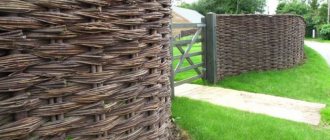Set of combination wrenches “Matrix”, polished chrome, 12 pcs.
762 ₽ More details
Set of combination ratchet wrenches “Matrix”, hinged, 6 pcs.
1850 ₽ More details
matrix calipers
Any house with two or more floors has stairs. To install the correct design, you need to know the installation standards for balusters. And one of the main rules is safe installation. Everything should be well fenced off from small children and pets. Balusters will give the stairs the best appearance. It will fit perfectly into the interior. They will also secure the structure. No one can fall. Wooden railings for stairs are selected for any room. They are sold in different types of trees, different structures, sizes, shades.
In this article we will look at how to properly install stair balusters. There are many types of installation, we will also talk about them in detail. Handmade wooden staircase railings are not difficult to make, the main thing is to adhere to the basic rules.
You can install the balusters yourself
Stylish on stairs
In addition to ease of movement in homes, railings also have an aesthetic function. With their own shade - dark or vice versa, carved or without this finishing, with corners or rounded and made of any material. Wrought iron railings for stairs are the most popular.
Railings can also be mounted into the wall. That is, there is room for creative thought and confirmation of your home design concept.
It is worthwhile to clarify not only these two terms. After all, many people get confused about them, even when placing orders with masters. Railings are the basis of the safety structure on stairs. Handrails are what a person leans on on a railing. They are, for example, like the head of a cane.
Another type of architectural grace is used in this set, which has passed from the external ancient buildings to the internal ones. These are balusters - shaped supports for stair railings. Today they are often ordered from marble, wood of the rarest tree species, for example, black.
Individual handrails for stairs are decorated with several, sometimes incompatible materials, for example, glass and cast iron. Wooden and metal parts are often combined to create stylish and surprisingly practical designs. Even polyvinyl chlorides (PVC) find a place in this niche.
Advice to customers of products for their own home: having focused your attention on one or another configuration, metal plastic (fashionable copper and bronze), compare them with the general aesthetics of the home interior environment. So that the staircase does not look eclectic, alien to your usual style
What tool will you need?
Preparation of the tool will depend on which parts of the wooden railings will be made by hand. If you order all the parts from specialists, providing them with drawings, this will significantly speed up and simplify the work. All you need is a screwdriver, self-tapping screws, bolts, wood glue, clamps, and a hacksaw. And, of course, a pencil, ruler, corner or level.
It is more convenient to use a modern power tool, which allows you to cut or sand something as quickly as possible. But sometimes hand tools also become useful. Thus, the edges of the cuts are often sanded with sandpaper. Correct the shape of the parts with a chisel or cutter.
If you want to make all the details with your own hands, then you need a surface planer and a jointer to trim the bars, slats, and boards. You will need a miter saw, a wood milling and lathe or a jigsaw (if balusters are cut from a thin board), and a grinding machine.
Peculiarities
The question of what the staircase will look like and what it will be constructed from should be decided at the design stage
It is extremely important to choose the optimal material, design and shape of the future structure, which should be safe, functional and stylish
Today there are several main types of staircase structures:
- marching flights;
- straight stairs;
- curved structures;
- turning stairs;
- screw devices;
- curvilinear;
- combined.
When designing stairs, there are several basic requirements:
- Every 9-10 steps, it is advisable to arrange small areas where you can rest and catch your breath.
- The minimum width of the steps should be 80 cm - optimally if 2 people can move freely on one step.
- The height of the steps that is comfortable for climbing is considered to be 15-20 cm, and it is better to build the depth within 25-30 cm.
- Landings must be wider than the flight of stairs.
- The entire structure as a whole should be tilted by a maximum of 45 degrees, and it is better if this parameter is within 25-30 degrees, otherwise the movement will be unsafe.
- Steps and other elements of the stairs must be fire-resistant; for this, the materials used must be treated with special fire retardants.
- The steeper the angle of ascent, the smaller the area allocated for the construction of the stairs. If the space is very small, then the staircase will be a spiral one with a large number of turns and bends - this option is often used to decorate a country house.
Many people believe that such barriers are only required by the elderly, sick people and families with children, since these are the categories of users who have the greatest problems with stability. And this approach is fundamentally wrong - even an adult needs a feeling of security, which is why railings must be installed on all types of stairs, without exception, so that any person, even an adult and absolutely healthy, can grab onto them in case of an unforeseen situation.
In addition to providing convenience, railings serve an aesthetic function. They can be dark or light, with or without carvings, angular, rounded, wooden, glass or forged. Railings can be attached to steps, or can be mounted into walls - such diversity allows you to realize any design ideas and emphasize the conceptuality of the style.
From a technical point of view, railings are vertically located structures that are attached along the edge of a flight of stairs. They include several basic elements:
- The basis of the fence, its supports, is the so-called baluster. It connects the steps to the handrail and ensures safe movement throughout the structure.
- Fence core is the materials that are attached between the balusters. They can serve a decorative function, but where children are constantly going up and down, such barriers are required.
- Handrails – serve as a support device for a person. As a rule, they are attached to the wall or to a baluster.
In addition, all types of aggregates have their own classification. So, according to the design option they can be:
- classic - that is, those that consist of vertically located or inclined rods, most often they are called figured;
- solid - very often, to ensure greater safety and prevent falls, solid panels are mounted, which are attached to the balusters;
- transom - this is a design in which vertical planks interconnect with each other by horizontal ones;
- Patterned is an artistic filling that can look anything in accordance with the user’s individual design.
Elements of fencing and opening design can be combined, creating stylish and effective combinations. In rare cases, balusters are replaced with bowstrings - these are horizontal fences that are mounted under the handrails parallel to human movement. Some railings have a cap, which is also called a cabinet - this is a part that is installed at the beginning and end of a flight of stairs instead of balusters. This is a purely decorative design that has no practical functionality.
Wooden railings for the terrace: a few words about painting
The price of wooden railings for stairs is quite justified, because wood, with proper care, can serve for a very long time and not succumb to destruction under the influence of moisture. Since wood is a rather vulnerable material, special compounds should be applied to it for maximum protection.
Paint is also used as a decorative coating, due to which you can change the appearance of the porch almost beyond recognition. In addition, the paint stimulates the manifestation of the natural structure of the material. Such compositions also help prevent the formation of mold.
To paint wooden railings for a balcony, you will need to acquire:
- chisel;
- sandpaper;
- rollers with large pile;
- brushes;
- brush, which will be needed to remove dust.
In addition, for painting you will need wood putty, which is necessary to seal small cracks on the surface, as well as a primer used to increase adhesion and form a protective layer. The main consumable material is paint, the selection of which must be approached with the utmost care.
Water-based solutions do not tend to resist the physical influence of atmospheric phenomena
For painting wooden products that are exposed to atmospheric conditions, special compounds are used. They are divided into the following types:
- oil paints;
- alkyd;
- water-based;
- reactive;
- polyurethane.
Oil paints contain special oils, in particular linseed and hemp. They are characterized by the ability to be perfectly absorbed into the wood surface.
This is interesting! Previously, precisely such compositions were used to paint wood surfaces, since they serve as excellent protection for the material. However, over time, their prevalence has decreased as they tend to emit a strong odor and take quite a long time to dry.
Water-based solutions emit almost no odor when applied and perfectly protect wood from the effects of ultraviolet radiation. However, they are practically not inclined to resist physical influence. That is why it makes sense to use this type of paint for railings or a wooden porch only if the structure plays the role of a decorative element.
Alkyd compounds provide reliable protection against moisture
Alkyds require much less time to dry than other compounds. It is thanks to this that they have gained great popularity. This type of paint is characterized by resistance to mechanical stress and provides reliable protection against moisture.
As for reactive compounds, they are made from pigment resins and a hardener. Before applying them to a wooden surface, these elements should be mixed. The result of the reaction between them is the formation of a protective film characterized by a high degree of hardness.
The most important characteristic of the composition, which is intended for painting wooden railings for the porch, is its resistance to external factors. Therefore, the choice should be made based on the following parameters:
- average temperature in summer and winter;
- the degree of influence of snow, wind and rain;
- level of mechanical impact.
To ensure that the paint lasts as long as possible, you should use all kinds of varnishes and protective agents.
In order for the paint to last for a long time, it is necessary to use all kinds of varnishes and other wood protectants. If you follow the above recommendations, the price of a wooden handrail for handrails will be justified not only by its highest reliability, but also by its beauty.
Railings for wooden stairs: installation options
It is worth noting that the method of manufacturing fences directly depends on the features of the interior, as well as on the type of wooden staircase for which they are designed.
For example, a distinctive feature of spiral staircases is their compactness. As for installation, it also does not cause difficulties and involves the installation of two types of balusters: large ones are mounted in the corners, and smaller ones are mounted on the steps.
At the tops of small racks, it is necessary to mark the angle of inclination of the staircase structure and carry out cutting. A hole needs to be drilled at the bottom. Moreover, its height directly depends on the size of the dowels. During the installation of these elements, you can add a little glue to increase strength. After this, the installation of balusters and main parts is carried out.
The method of making railings directly depends on the features of the interior and the type of staircase itself
For screw structures, you will need to create a bowstring of a curved shape.
Then the workpiece must be fixed in the desired position and dried. After this, you should connect all the parts of the stairs.
It is worth noting that the fences can be forged. Such railings for a wooden staircase in a private house are a sign of the excellent taste of its inhabitants. The key point when creating a tandem of wood and metal is to ensure the correct and reliable connection. However, speaking about the material for wooden stairs, it is worth noting that additional elements made from natural material have no equal.
The process of making handrails for stairs in a private house is long and painstaking.
If we are talking about creating a combined structure, then assembly adhesive and a groove system are used. In addition, you can use elements for fastening, including self-tapping screws. Having decided to combine forged balusters with wood, you should arrange for the joint to be treated with an anti-corrosion compound.
The process of creating wooden staircase railings in a private house is quite long and painstaking, and caring for them requires some effort, which is fully justified by creating a stylish and luxurious look for the house.
In buildings with several floors, stair railings are a necessary attribute to ensure safety on the stairs, balcony or terrace. In addition, wooden railings will add sophistication to the interior and become an elegant decorative element.
Choosing wood for balusters
For such products it is better to use hard wood.
- Oak planks. They are very hard. They will last a long time due to their strength and durability. They will be able to withstand strong masses. Handmade stair railings will not wear off during installation and use. Insects cannot harm them.
- Beech boards. Also durable. But, in addition to strength, they have flexibility. Therefore, they are often used for carved railings; they are easy to deform. But before installation it is better to treat with antiseptics.
- Ash boards. They are similar in structure to oak. But they are less durable. The positive side is that they are resistant to rot. Because of this, ash boards last a long time.
- Pine boards. It is easy to process. They will never rot (due to the resins they contain). If there are sudden temperature changes, they will not be deformed. Very durable. Compared to other woods with the same properties, they are low in cost.
- Deciduous boards. Very durable. They do not wear out over time. They are distinctive in that they gain their strength during service. This is due to the special composition and structure of the wood.
- Birch boards. Experts do not recommend using them for railings. They are fragile and rot quickly. But if you don't put much stress on your wood stairs and are doing them purely for decorative purposes, they are great. They are easy to process and have an aesthetic appearance.
Important! Before purchasing the wood you need or ready-made railings, inspect it carefully. It is not recommended to purchase if it has transverse cracks, knots, or the presence of insects.
Basic requirements for fencing
First and foremost, railings must be safe and useful. Their task is to support a person during descent and ascent, and to prevent falling from the porch. Still, aesthetics is also considered an important factor. To fulfill the assigned tasks, the railings are built in accordance with certain rules:
- The material of the fence and steps must be the same or well combined. You can often find beautiful porches made from several materials: stone and wood, metal and plastic, aluminum and glass.
- The strength of the fence must be sufficient for a point load of 100 kg.
- The railings are made comfortable and ergonomic. Their surface can be easily grasped by a medium-sized palm; the upper part of the railing has a cross-section of about 40x70 mm. The material chosen for the handrail is pleasant to the touch, does not cool down in winter and does not heat up under the sun. The surface is polished, leveling protrusions and burrs.
- The height of the fence must be at least 90 cm - this is a requirement of building regulations. If there are small children in the house, you need to make an additional handrail for them at a level of 50-60 cm.
- The handrail rests on two pillars. These are the supporting structures of the porch; they should be more durable and have reliable fixation.
- Balusters are installed between the support posts. Their task is to prevent a person from falling out through the side surface of the porch. According to SNIP, no more than 15 cm of gap must be left between balusters.
Materials used
Finishing the stairs to the second floor
It is obvious that the material of wooden balusters is wood. Balusters can be made of oak, ash or beech. Accordingly, metal ones - made of steel, iron, chromium and even aluminum.
But more and more often combined balusters are appearing on sale. One of their advantages is that they are suitable for almost all types of stairs. The most common combination is metal and wood.
Based on the type of combination of these materials, balusters can be divided into two types:
- metal stand with wooden decor;
- wooden baluster with metal decor (most often stainless steel).
Both options are elegant, the only difference is in price due to the different consumption of materials. Wood in combination with metal in the interior will always look advantageous, regardless of whether the wooden stand is decorated with metal parts or, conversely, the metal stand is decorated with wood.
Of the two types of combined balusters, models with a metal core and a wooden attachment have gained popularity. The price for one piece fluctuates around 300 rubles. The core is usually made of chrome or stainless steel, and the wooden head can be made from pine, oak or ash upon request and to order. The thickness of the metal, as a rule, is not large - only 1–2 mm. But at the same time, consumers note that such models are durable.
How to weld a railing with your own hands: necessary tools, main stages of work
Even though the design is modest, metal railings can be made in a variety of ways. For example, when creating complex structures, a welding method is used that is suitable for steel and ferrous metals. The main thing is that the joints are absent or barely noticeable. Before welding a metal staircase, you need to prepare the following tools:
Usually, railings are made from a profile pipe using welding.
- grinder with cutting and grinding disc;
- drill with metal drills;
- welding machine;
- vice;
- level and squares, with the help of which marking of structural parts is carried out;
- suitable fasteners.
Typically, welding is used to produce railings from a profile pipe. For manufacturing you will need 2 pipes of suitable length and diameter. You should not do the work by eye; to obtain the ideal product, it is first recommended to make a simple drawing taking into account the dimensions of the opening.
When creating the simplest option, you will need to weld a supporting frame from pipes or channels, to which the corners are then welded, serving as the basis for the steps. After the frame is ready, all seams need to be sanded and ensure that there are no metal burrs or other irregularities that could scratch your hands.
Having completed the welding work, proceed to the next stage: a primer or paint for metal surfaces is applied to the finished product. This must be done to protect the product from corrosion and give the railings an attractive appearance.
The simplest version of the staircase is a supporting frame made of channels, to which the corners are welded, which are the basis for the steps
Both handrails and vertical supports are made from a profile pipe, which can be easily welded to a finished metal staircase using the same welding machine. A finished staircase with railings can last 30 years or longer if properly used. The main thing is to prevent the development of corrosion in time.
Requirements for the height of railings and fences
For buildings and structures for various purposes, GOST requirements provide special standards that are designed to ensure fire safety and ease of use of stairs. Standard sizes are provided for the following structures:
- flights of stairs located in residential, public and industrial buildings;v
- stairs in kindergartens and other preschool institutions;
- fencing of balconies and loggias;
- fencing of open gazebos, terraces and verandas;
- ramps for the disabled.
Stairs
The distance from the floor surface to the top of the handrail should be 0.9 m - these are the requirements for the height of the handrail on the stairs. GOST 25772-83 provides this size for private houses, public and industrial buildings, residential high-rise buildings, shops.
Some public buildings have three flights of stairs. According to the standards, such flights do not need to be equipped with a handrail, but if there is a lot of traffic from visitors to this institution, it is recommended to equip the stairs with a fence. There are no special height requirements in this case, but most often it is from 80 to 90 cm.
Balconies and loggias
The height of the railing on the balcony is a barrier that ensures the safety of people on the upper floors in residential and public buildings. The minimum size of a balcony railing is considered to be a railing height of 120 cm or more. This size allows you to reliably protect small children from accidentally falling out of the balcony or loggia.
Modern standards allow for panoramic glazing of loggias and balconies, but for the construction of the lower part of the fence it is necessary to use materials of increased strength that can cope with lateral loads.
Terraces and verandas
When constructing open terraces and verandas at a height of more than 30 cm from ground level, it is necessary to provide railings. Regulates the height of the railings on the terrace according to GOST 25772-83.
The height of the railings on the veranda, as well as the distance between the balusters, should not interfere with a comfortable view from a sitting position.
Ramp guards for disabled people
When making handrails for ramps, it should be taken into account that an applied load of 50 kg at any level must be successfully withstood by the structure. When designing handrails for ramps, the following rules must be observed:
- The optimal design of handrails for ramps is considered to be the organization of two levels, which are located parallel to the angle of descent from the flight;
- the top handrail is installed at a height of 90 cm;
- the lower handrail is installed at a height of 70 cm;
- to ensure comfortable descent and ascent, the handrail is equipped with a 30 cm reach beyond the outer fence post;
- both handrails must be securely fastened to the base of the fence and connected to each other;
- if a single-tier handrail is used to enclose a ramp, it is additionally secured to adjacent walls or other structural elements.
If a porch with a ramp is equipped in a children's institution, it is necessary to install a second additional handrail at a height of 0.5 m so that the child can reach the railing when descending or ascending.
Fencing for kindergartens: standards
The total height of the stair railing in a regular kindergarten is 120 cm, and for specialized children's institutions for mentally retarded children - 150 cm.
There should be no breaks in the kindergarten stair railing. When manufacturing solid railings, it is not always possible to transport and install the entire product. Therefore, structural parts are welded on site
It is important that the seams are neat, without sharp elements and carefully sanded and polished.
The ends of the railings should be rounded so that children cannot get hurt on them.
Since kindergartens involve visitors of several age groups, it is necessary to provide three different heights of railings:
- For adults – 90 cm;
- For children of the senior and preparatory groups – 70 cm;
- For babies – 50 cm.
Stair railing posts must be vertical. The space between them is filled with vertical metal balusters at intervals not exceeding 10 cm. A good alternative or addition are screens installed on stair railings - they reliably protect children from falling. However, it should be noted that according to GOST, the manufacturer of the staircase is not obliged to supply it along with the screens.
Installation of stair railings: how to attach handrails and balusters
It is very important to reliably install stair railings, since the safety of people depends on it. There are several ways to make a staircase railing in a private house
There are several ways to make a staircase railing in a private house.
Attaching the handrail to the wall.
The handrail is attached to the wall when the staircase is located near it. With this option, racks will not be needed; the handrails will be installed using special brackets.
Their size should be calculated so that the distance from the handrail to the wall is no more than 10 cm.
Brackets for handrails are cast and hinged. When using hinged brackets, it becomes possible to adjust the inclination of the handrail, which is very convenient when using the stairs.
This design is easy to assemble and just as easy to dismantle.
Attaching balusters to steps.
Balusters can be installed in three ways.
- Single fastening of balusters is the simplest, but at the same time less reliable method. In this case, the stand is fixed only on the anchor (dowel).
- Flange mounting involves mounting the flange with self-tapping screws. For greater reliability of fastening, it is recommended to use several self-tapping screws.
- Anti-vandal fastening of fences is the most reliable. In this case, it is necessary to drill holes in the steps using a drill, and then place mortgages in them, onto which pipes for the railings will subsequently be attached.
Attaching balusters to the end of the step.
It is recommended to use such fastening in cases where the distance between flights is at least 70 cm.
The baluster is mounted on the end using two anchors.
There are four ways to attach balusters to the end of a step.
Fastening balusters on two expansion anchors through a sleeve
This method is recommended for use in cases where it is necessary to place the stand at a short distance from the step.
It is necessary to screw a cap nut onto it, which performs expansion and fixing functions.
Lateral fastening of balusters.
When fastening from the side, the balusters should be threaded into special holders and secured. In this case, expansion anchors secure the balusters to the flight of stairs.
When mounted on two expansion anchors without using a bushing, the post fits closely to the end of the step. This installation differs from the first method only in that it does not require the use of a bushing.
Fastening balusters to a chemical anchor.
In this case, fastening is done using chemical or liquid nails, which are an adhesive substance that penetrates deeply into the concrete. This chemical anchor is characterized by a fairly strong fastening.
This method is recommended for use when there is a need to secure stair railings into a concrete structure. So, you need to insert an anchor and a pin into the hole filled with the mixture. After the balusters are secured, you can proceed to the remaining installation of the railings - in the same way as when installing using the “on-step” method.
Some ideas for creating beautiful metal railings
When choosing railings, you need to take into account not only individual wishes, but also the harmonious combination of products with the interior. Some stairs look original without railings, but the question of safe use remains open. Therefore, it is better to supplement any design with handrails. Attractive design options:
For a classic interior with elements of aristocracy, forged and cast railings are best suited
- cast iron stairs look bulky and massive, but are not suitable for every interior;
- forged and cast railings will fit into a classic interior with elements of aristocracy;
- various patterns will fill the room with a palace motif;
- an openwork version of metal railings will add lightness to the staircase and transform any design
- a wooden staircase with metal railings will emphasize the rustic style, chalet interior or classic style;
- Using a variety of weaves, shapes and geometric shapes will help create a real work of art in the house.
A staircase is an integral element of a house or apartment of several floors. The entire structure is a continuation of the interior. Railings that continue the pattern of the walls will look very beautiful and harmonious. When choosing a railing design, you should not forget about safety rules. Metal is a durable material, but even despite this, you should properly install the railings and take care of them, only in this case you will be able to create not only a beautiful, but also a safe interior.
The final stage of production - painting
Painting
You can paint the railings with a brush or spray. Don't forget to prime the metal before doing this. Interestingly, only white primer will hide small irregularities, which will make the paintwork smoother. When choosing paint and primer, pay attention to the composition, because they must be compatible. Each layer must dry well.
If you want your wrought iron railings to look chic, you should apply a wrought iron patina. So, you can decorate some forging elements. The manufacturing process is now complete. All you need is to install the fence in a permanent place.
Do you already have experience in manufacturing and installing railings? Then write us comments. Your experience will be useful to us!
